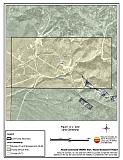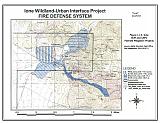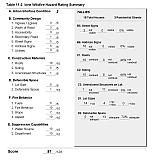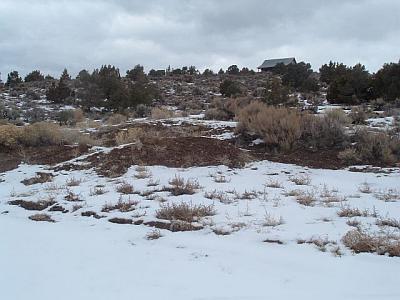11.0 Ione
11.1 Risk and Hazard Assessment
Ione is located in northwestern Nye County north of the Berlin-Ichthyosaur State Park. The small remote community is situated at approximately 7,000 feet in elevation on south-facing, gently sloping topography on the west side of the Shoshone Mountains. There is no private land in Ione; it is a historic mining community built on public land. The community hazard assessment resulted in classifying Ione in the Extreme Community Hazard category (97 points). The hazard rating was primarily attributed to limited access to water, steep terrain, heavy fuels, and the distance (greater than one hour) from an organized fire department. A summary of the factors that affected the hazard score is provided in Table 11-2.
11.1.1 Community Design
The wildland-urban interface area around Ione is characterized as an intermix condition: structures are scattered throughout the wildland area with no clear line of demarcation between wildland fuels, structures, and the open space throughout the community. Fourteen of the eighteen houses observed in Ione were on parcels less than one acre in size, the remaining four were on parcels between one and ten acres indicating an overall high density of houses (Figure 11-1).
- Roads: Ione is accessed via a graded dirt road between twenty and 24 feet wide. A majority of secondary roads in the community have grades steeper than five percent.
- Signage: Due to the small size of this particular community, nearly all streets and residences are clearly visible upon approach. However, no signs were posted on the main road and no addresses were posted on the long driveways leading up to residences. Clear and visible signage is important to assist firefighters in locating residences during poor visibility conditions that occur during a wildland fire.
- Utilities: All of the utilities were above ground. Power for the community is supplied by local generators.
11.1.2 Construction Materials
Ione began as a mining town in the 1860s and the building construction materials reflect that era. The majority of the homes observed in the interface area were built with wood siding materials. Some of the structures had corrugated metal roofing, but 56 percent had combustible materials such as wood shingles. One of the homes observed had an unenclosed porch that could create drafty areas where firebrands can accumulate, smolder, ignite, and rapidly spread fire to the home.
11.1.3 Defensible Space
The majority of the homes observed (72 percent) met the minimum recommended defensible space guidelines to help protect the home and minimize damage or loss during a wildfire.
11.1.4 Suppression Capabilities
Wildfire Protection Resources
There is no organized fire department in Ione. The closest fire station is in Gabbs, which is more than an hour away (24 miles on dirt roads). Gabbs currently has no response capability to assist with a wildland fire near Ione since all of their suppression apparatus is in need of repair. Table 11-1 lists the types of wildfire resources, cooperating partners, and equipment available to Ione in the event of a reported wildland fire.
| Type of Equipment | Amount of Equipment | Cooperating Partner (Resource Location) |
|---|---|---|
| None | ||
| Brush Truck Type I Engine |
1 - Out of Service 1 - Out of Service |
Gabbs Volunteer Fire Department (Gabbs) |
| Type 6 Engine | 1 | Berlin-Ichthyosaur State Park (Berlin) |
| Source: Personal conversation with Gary Fly, bar owner in Ione, March 2, 2004 | ||
Additional resources are available through the fire departments in Hadley, Manhattan, and Tonopah, dispatched through the Nye County Sheriff Department. Resources can also be obtained from the Nevada Division of Forestry Tonopah Conservation Camp, as dispatched through the Sierra Front Interagency Dispatch. Bureau of Land Management and US Forest Service suppression resources are dispatched through the Central Nevada Interagency Dispatch Center. It is important to note that the actual number and type of suppression resources available to respond from neighboring fire departments and agencies is dependent upon the resources on hand at the time of the wildland fire call.
Water Sources and Infrastructure
There is one fire hydrant in the community. The water source for the hydrant was reported to be gravity-fed from a well. There were several private wells in the community operated by generators. No water storage tanks or ponds were identified during field reconnaissance.
Detection and Communication
There is no landline phone service in Ione. Cell phones and satellite phones operate, although inconsistently. When service is available, fires can be reported through 911 calls to the Nye County Sheriff and fire suppression resources are dispatched through the Nye County Sheriff’s Office in Tonopah.
Community Preparedness
The community is located 61 miles south of Austin and 96 miles northwest of Tonopah on public land. There has been no formal coordination between the Bureau of Land Management or the US Forest Service and the community regarding community preparedness for a wildfire (G. Fly 2004 pers comm.). The Nye County Local Emergency Planning Committee maintains an Emergency Plan for hazardous materials and an All Risk County Plan.
11.1.5 Factors Affecting Fire Behavior
Vegetation, dead and down fuels, and topographical features contribute to the potential fire hazard within the wildland-urban interface. Ione is situated in a narrow canyon that runs southwest to northeast. Erratic winds are common due to the terrain. Predominant winds blow from the south and southwest upslope and into the canyon. Heavy fuels in the canyon surround the town (see Figures 11-2 and 11-3). The fuels are composed of sparse to dense pinyon and juniper with a shrub understory of sage up to five feet in height. Ground fuels are abundant consisting of cheatgrass and perennial grasses. The interface fuel hazard condition ranges between moderate and extreme.
11.1.6 Fire Behavior Worst-case Scenario
The worst-case scenario would occur on a high hazard day on the 4th of July when several hundred tourists visit this old mining town. An ignition southwest of town caused by a dry lightning strike or a careless tourist could spread rapidly, driven by winds through the dry fuels. A fire could quickly burn upslope through the canyon directly into and all around Ione, trapping several hundred tourists. Fire resources several hours away would be of little help. Spot fires could ignite several additional fires and the old wood structures could be quickly consumed. The vegetation in this area with the steep canyon slopes could create flame lengths of over 100 feet.
11.1.7 Ignition Risk Assessment
Large gatherings of tourists and visitors occur during special occasions and holidays that intermittently influence the ignition risk and evacuation safety. There is a high potential for fire ignition due to heavy, continuous fuels within and around the community. The primary ignition risks are lightning in the surrounding mountains and human causes such as unextinguished cigarettes, campfires, or other careless human behavior. Five fires, all less than forty acres, have been recorded within seven miles of Ione since 1992.
11.2 Previous Site Assessment Summary
The Bureau of Land Management Battle Mountain Field Office completed a site assessment for the Ione community in May 2003 and reported heavy fuel loadings within Ione Canyon, Shamrock Canyon, and the wooded areas north and west of town.
The BLM proposed the following treatment alternatives in the site assessment. Some treatment areas cross administrative boundaries between the BLM and the US Forest Service. Figure 11-4 shows the proposed treatment areas.
- Mow sagebrush and shrubs, re-seed (greenstrip), and thin pinyon and juniper over 234 acres to the west and south of Ione,
- Create a 73 acre shaded fuelbreak in Shamrock Canyon,
- Create a 32 acre shaded fuelbreak in Ione Canyon, and
- Thin and mow vegetation within 137 acres northeast of Ione.
The BLM expects to begin a phased implementation of these treatment alternatives beginning in 2005.
11.3 Risk and Hazard Reduction Recommendations, Roles, and Responsibilities
The Ione risk and hazard reduction recommendations address the primary concern regarding lack of fire suppression resources and limited water resources. Other recommendations pertain to community coordination and public education efforts that could be initiated to enhance fire safety in Ione.
11.3.1 Defensible Space Treatments
Defensible space treatments are an essential first line of defense for residential structures. The goal of the treatment is to significantly reduce or remove vegetation within a prescribed distance from structures. (Specific guidelines for defensible space are dependent on fuel type and topography and are given in Appendix E.) Defensible space reduces fire intensity and decreases the potential for loss or damage to structures in the event of an oncoming wildfire.
Property Owner Responsibilities
- Remove, reduce, and replace vegetation around homes according to the guidelines in Appendix E. This area should be kept:
- Lean: There are only small amounts of flammable vegetation,
- Clean: There is no accumulation of dead vegetation or other flammable debris, and
- Green: Existing plants are healthy and green during the fire season.
- Maintain the defensible space condition as needed.
- Immediately remove cleared vegetation to an approved disposal site when implementing defensible space treatments. This material dries quickly and presents a fire hazard if left on site.
- Where cheatgrass has become dominant within the defensible space zone, areas should be mowed prior to seed set, or treated with an application of a pre-emergent herbicide. Prescribed treatments may need to be repeated for several years to ensure that the bank of unwanted annual plants seeds has been depleted. Refer to Appendix E for a recommended seed mixture and planting guidelines that can be used in conjunction with cheatgrass removal.
- Clear around propane tanks for a minimum distance of ten feet and maintain this area free of accumulated vegetation and combustible materials.
- Remove flammable materials and other debris from the defensible space area.
- Store lumber, firewood, and other potentially flammable materials a minimum distance of thirty feet from structures.
- Mow or remove brush, weeds, and other flammable vegetation growing against fences that adjoin structures in the community.
- Install spark arrestors on chimneys.
- Remove or properly enclose trailers and buildings that have been abandoned to prevent unwanted ignition from sparks or firebrands.
- Leaves, and debris should be removed from roofs and rain gutters.
- Prune pinyon and juniper branches four feet from the ground (but not more than 1/3 of the tree crown) to reduce ladder fuels. All dead and diseased branches and duff should be removed from beneath remaining trees.
- If residents elect to keep some pinyon or juniper trees close to the home for aesthetic reasons, there must not be any other native trees or ladder fuels within a minimum of thirty feet of the crown of the tree.
- Prune trees so that the branches are at least fifteen feet away from chimneys and or structures.
11.3.2 Fuel Reduction
Fuels reduction treatments are applied on a larger scale than defensible space treatments. By permanently changing the fuel structure over large blocks of land to one of lower volume or reduced flammability with a fuel reduction treatment, the expected result in the event of a catastrophic wildfire would be one of reduced capacity for uncontrolled spread through the treated area.
Homeowner Responsibilities
- Mow cheatgrass, reduce brush, and thin trees along driveways for a minimum width of twenty feet on both sides. Brush should be thinned to a spacing of two times the height of the shrub.
- Mow or otherwise remove all vegetation within ten feet of the fire hydrant to improve visibility and access. Ensure residents are trained in the use of the hydrant.
Bureau of Land Management and Homeowner Responsibilities
- Remove all trees within 25 feet of each edge of the main road through the community. Thin an additional area of 25 feet wide to approximately ten trees per acre. Thin shrubs to a distance two times their height for the entire fifty-foot wide treatment area.
Bureau of Land Management and US Forest Service Responsibilities
Continue to coordinate implementation of the fuel reduction treatments around Ione, especially Shamrock Canyon, on the Humboldt-Toiyabe Austin Ranger District as proposed in the BLM site assessment.
11.3.3 Community Coordination
Coordination among local, state, and federal fire suppression agencies is important in the day-to-day fire prevention activities and becomes critical in the event of a wildland fire. During a fire event, firefighters from other communities and states may be dispatched to areas they have never been before. This is particularly true in areas that have limited fire suppression resources and will be dependent on an outside agency in the event of a catastrophic wildland fire.
Property Owner Responsibilities
- Form a local chapter of the Nevada Fire Safe Council. The Nevada Fire Safe Council proposes to work on solutions that reduce the risk of loss of lives and property from wildfires in Nevada’s communities. Through the establishment of a local Chapter, communities become part of a large information-sharing network that receives notifications of programs and funding opportunities for fire mitigation projects such as those listed in this report. The Nevada Fire Safe Council will accept and manage grants and contracts on the Chapter’s behalf through its non-profit status. The Nevada Fire Safe Council provides assistance and support to communities to complete fire safe plans, set priorities, educate and train community members, and promote success stories of its members. For more information on forming a chapter, contact;
Nevada Fire Safe Council
1187 Charles Drive
Reno, Nevada 89509
(775) 322-2413
www.nvfsc.org
- Participate annually with the Bureau of Land Management to discuss their pre-attack plans for the public lands surrounding the community.
- As an evacuation plan becomes available, read and become fully knowledgeable of evacuation procedures, fire safety zones, and safety procedures for sheltering in place in the event that evacuation is not possible.
Nye County Responsibilities
- Work with local residents to prepare an evacuation plan for special events and holidays. Post the plan in the community for visitor awareness and distribute the plan to all residents. This plan should include information regarding evacuation routes, evacuation procedures, designated fire safe zones, and procedures for sheltering in place in case evacuation becomes infeasible during a fast moving firestorm.
BLM and USFS Responsibilities
- Station a brush engine in or near town during special events and holidays such as the 4th of July when large numbers of visitors converge in Ione.
11.3.4 Public Education
Public education focused on increasing community fire safety is critical. A program that explains fire safe measures in clear and emphatic terms will have an impact on residents in the wildland-urban interface. Informed community members will be more inclined to take actions to effectively reduce fuels and other wildfire hazards around their homes and in their neighborhoods.
Property Owner Responsibilities
- Contact the BLM Battle Mountain Field Office and the University of Nevada Cooperative Extension for assistance with programs for public education.
- Obtain copies of the publication “Living with Fire” for all property owners. This publication is free of charge. Copies can be requested from the University of Nevada Cooperative Extension.
11.3.5 Equipment and Training
BLM Responsibilities
- Coordinate with Nye County to purchase and install a 15,000-gallon water tank to provide the Bureau of Land Management and the US Forest Service with a nearby drafting site for their engines in the case of a nearby wildfire. This additional water storage capacity will also provide local residents an additional resource for use on small fires.
Nye County Responsibilities
- Identify and train a minimum of four residents from the community of Ione with the Basic Wildland Firefighter Training course.
- Station a pick-up truck and a one-piece, slip-on, 100 to 200-gallon pump and tank unit with hose and hose reel in Ione. This equipment, fitted properly for the size and weight of the truck, can be used by the trained residents to provide initial attack on wildfires threatening the community.
Figure 11-1Ione Land Ownership |
 |
Figure 11-2Ione Fuel Hazard Classification |
 |
Figure 11-3. Ione Fuel Hazard Photo Points
Photo Point 1. N 4311418 E 0449191 46°NE. Overview of Ione looking up Ione Canyon. Aggressive establishment of defensible space is needed to protect buildings from the moderate fuels in the immediate vicinity and the extreme fuels present on the surrounding hillsides.
Photo Point 2. N 4311433 E 0449072 319°NW. Ione is characterized with heavy fuels surrounding the community. The vegetative fuel load associated with the sagebrush dominant vegetation was estimated at two to five tons per acre and was considered a moderate to high fuel hazard. The pinyon and juniper dominated sites were considered an extreme fuel hazard.
Figure 11-4Ione BLM and USFS Planned Mitigation Projects |
 |
Table 11-2Ione Wildfire Hazard Rating Summary |
 |


